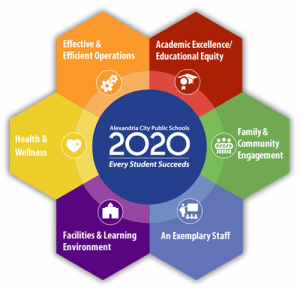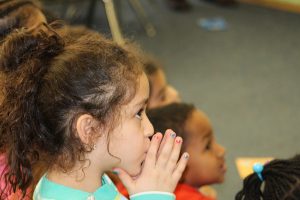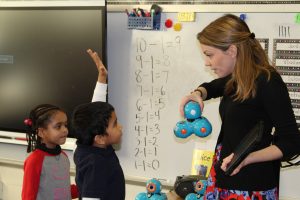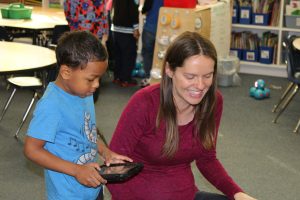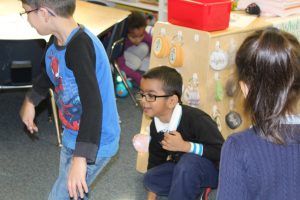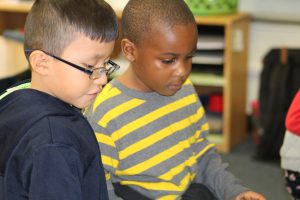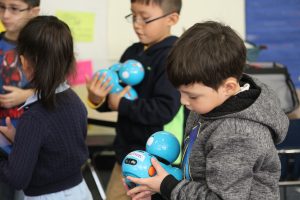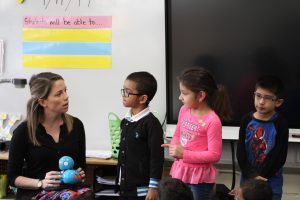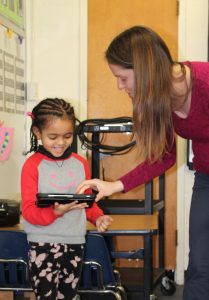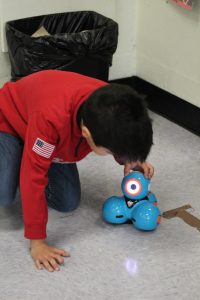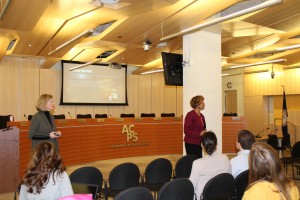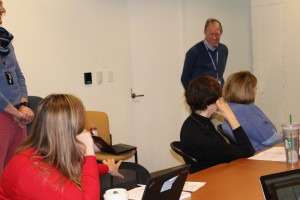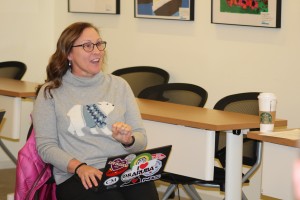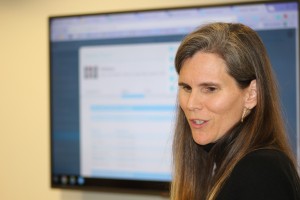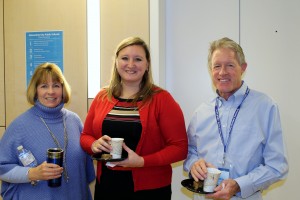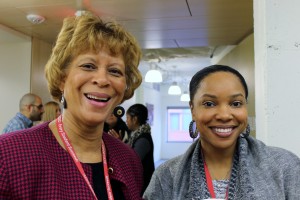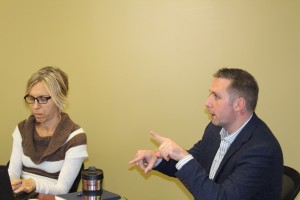As part of the ACPS 2020 Strategic Plan, ACPS will promote efforts to enable students to be healthy and ready to learn. This includes fostering a balanced use of digital tools. As families navigate the use of screens for school and entertainment purposes, the following articles and guidelines are helpful for making decision in your home. In ACPS, we focus on the quality of screen time, aware that the devices available to modern students are their learning tools. We center our planning on what children are doing with digital tools, aware that how they interact with devices is what matters most. Screen Time in the Balance by Linda A. Estep was published in the International Society for Technology in Education’s (ISTE) April 2016 entrsekt magazine. ISTE has provided ACPS privileges to share this with families.
About
“Dash”-ing Around Kindergarten!
There are some new faces at William Ramsay Elementary School! On January 11, Technology Integration Specialist Caroline Doughty entered Mrs. VanKuiken’s Kindergarten classroom with a cart filled with 10 Dash robots and iPads. Mrs. VanKuiken is part of a team of teachers from William Ramsay participating in Coding in the K-3 Classroom. Throughout the division, twenty teams of teachers are utilizing Dash and Dot robots to promote deep and meaningful learning experiences through creativity, collaboration, and critical thinking. The students were on the edge of their seats as they learned about their math activity for the day!
Ms. Doughty explains, “As part of Coding in the K-3 Classroom, kindergarten students are using Dash robots to explore curriculum topics and computer science. Students in Mrs. VanKuiken’s class used the Wonder Workshop app, Go, to drive Dash around the room and find numbers in sequential order. The students worked collaboratively in groups of two or three and learned how to manipulate Dash’s wheels, lights, and sounds. After arriving at each number, the students were tasked with exploring a new feature in the Go app. At number 1, students learned to manipulate  Dash’s eye color. Halfway through the hunt at number 5, students learned how to make Dash dance. The journey ended at 10 where students were able to record their voice and teach Dash new words! The lesson directly correlated to the kindergarten math curriculum and SOL K.4. In addition, students were introduced to the basics of robotics and computer coding, using picture codes to navigate their robot. The students reacted that it was “the best day ever” as they problem-solved and had fun learning and exploring together!”
Dash’s eye color. Halfway through the hunt at number 5, students learned how to make Dash dance. The journey ended at 10 where students were able to record their voice and teach Dash new words! The lesson directly correlated to the kindergarten math curriculum and SOL K.4. In addition, students were introduced to the basics of robotics and computer coding, using picture codes to navigate their robot. The students reacted that it was “the best day ever” as they problem-solved and had fun learning and exploring together!”
Jessa Henderson, a Technology Integration Specialists at T.C. Williams, participated in the lesson with the students. Working with the kindergartners provided her with a different view of coding, as her background is in secondary education. Mrs. Henderson expressed, “Coming from a high school perspective, it was not only impressive to watch such young students complete the assigned challenge with Dash, it was inspiring to know these students are being exposed at such an early age to the problem solving, teamwork and coding skills that will be critical for success in our 21st century economy.
I witnessed, in awe, as students coached their classmates on how to improve their navigation skills by using supportive and direct language.
Students worked together to problem solve when obstacles were encountered. In one instance, a group’s Dash became stuck under a table. The group, aware of the directions that students were unable to pick up dash and only navigate from the app, talked through possible solutions and opted to move chairs from under the table. This gave the students a more open path with which to help Dash navigate safely to his/her objective. To these students, this seemed more like fun, play time than an integrated math and technology lesson. Yet, in this time, each student began the important task of building up the foundation of skills necessary to be a critical thinker, teammate and problem solver. With technology-related fields increasing at a rapid rate, often without the adequate staffing to fill the demand, these students are setting themselves up for success in the 21st century economy.”
The gallery below shows highlights from the lesson.
Blended Learning MiniCamp
On Friday, January 6th, members of Technology Services and members of the Curriculum and Instruction Office engaged in a Blended Learning MiniCamp! ACPS defines blended learning as the deliberate connection of educational technology with face-to-face instruction to enhance and personalize a deep and meaningful curriculum. The welcome message from Dr. Elizabeth Hoover, Chief Technology Officer, and Dr. Terri H. Mozingo, Chief Academic Officer, included a look at blended learning in ACPS and how blended learning strategies support the ACPS 2020 Strategic Plan.
The purpose of the camp was to foster rich conversations regarding the use of technology resources and how, when coupled with face-to-face instruction, they benefit students in ACPS. Participants shared the ways teachers utilize creation and engagement tools in the classroom, and discussed when and how these resources are appropriate for learning. During lunch, Dr. Crawley participated in small group discussions regarding the continued work between departments to support teachers and best meet the needs of students in ACPS. One participant stated, “ACPS has many different technology tools that can help teachers more efficiently collect data and build student engagement at the same time.” The MiniCamp was a huge success and a great opportunity for collaboration amongst colleagues!
Common Sense Media
In ACPS, we promote efforts to enable students to be healthy and ready to learn. This includes safe, ethical, and respectful behaviors when interacting with peers and adults in digital environments. We aim for all students to understand the rights, roles, and responsibilities of being digital citizens. 
ACPS is proud to be a Common Sense Education Certified Digital Citizenship District! Common Sense Media is a non-profit organization that provides support for students, families, and schools to promote safe and responsible use of media. Use the link below to explore their resources, including ratings and reviews.
ACPS and Blended Learning
ACPS defines blended learning as the deliberate connection of educational technology with face-to-face instruction to enhance and personalize a deep and meaningful curriculum. This year, administrators, technology integration specialists, and teachers will participate in blended learning cohorts to build and define the ACPS Blended Learning Model! This is an exciting opportunity for our division, as blended learning support the ACPS 2020 Strategic Plan. To kick off the year, ACPS held the first annual Blended Learning Camp in August!
 Loading...
Loading...
Common Sense Media Curriculum
